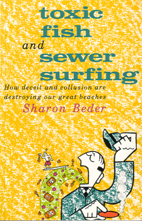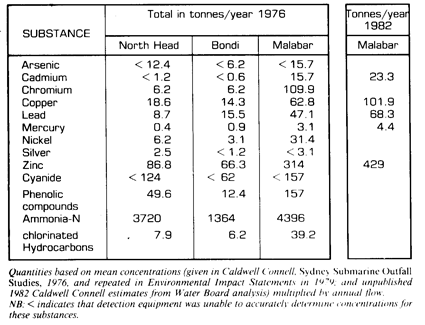
by Sharon Beder
first published by Allen & Unwin, Sydney, 1989
Introduction
Sewers seaward
Toothless watchdog
Toxic fish
Sewer-side surfing
Public relations battle
Events of 1989
Beyond Sydney
Conclusion
Bibliography
At the other end of the system, the Board does not seem to have been doing any monitoring whatsoever to see if its trade waste policy has been working. It appears that the Board still does not know what quantities of restricted substances go through its treatment plants and enter the ocean. Virtually the only published figures were estimates given in a 1976 report and repeated in the Environmental Impact Statements or the extended ocean outfalls in 1979 (shown in Table 3.1).
Table 3.1 Toxic substances in sewage and sludge

Hundreds of tonnes of heavy metals and toxic chemicals were being discharged into the ocean from Sydney's ocean outfalls in the 1970s, including more than 4 tonnes of mercury, more than 15 tonnes of cadmium and more than 70 tonnes of lead. More recent figures are difficult to find but l 982 figures show that quantities being discharged at Malabar had increased markedly; mercury by more than 30% and others by even more. Quantities of pesticides and other organochlorines being discharged into the oceans have never been measured although they are accumulating in fish.
When it was revealed in January 1989 that monitoring of toxic substances in sewage discharged to the sea was not being carried out, the Board promised that it was beginning to do it. I contacted the Board in April and was told that they were still working out a way of taking samples that would be ‘truly representative’ and that the first results could not be expected till July. This is very puzzling, since the overseas expert brought to Sydney by the Board in March claimed that his organisation had been keeping excellent records of concentrations of restricted substances in Californian effluents for at least twenty years.
The old trade waste policy failed abysmally at keeping toxic waste out of ocean waters and from accumulating in fish. The new trade waste policy does not offer any radical departure in philosophy except a move towards self-monitoring of industrial wastes by industry. There is nothing in the new trade waste policy that can assure the community that fish and seafood consumers will not continue to suffer the results of toxic waste dumping in the ocean. The Board has not even been concerned enough to monitor its own performance at the outfalls, despite its knowledge of alarming levels of waste accumulation in fish.
The SPCC certainly did not require this monitoring, nor did it set limits in Water Board licences for toxic substances in the outfalls until the 1987 and 1988 bioaccumulation studies receive; publicity. Even then limits were only set for those substances that showed the worst results in the publicised studies. If licence limits for other toxic substances can be delayed till after the extended outfalls are built. Those limits will be far looser than if they were set now because the SPCC will assume greater dilution will be achieved with the new outfalls.
This is a major reason why extended outfalls have been preferred to the alternatives. Secondary treatment or sewage farming means more restrictions on what industry can put down the sewers, because toxic chemicals can kill the micro-organisms that break down the sewage. But extended outfalls operating under SPCC standards will leave industry free to put even more toxic waste down the sewers.